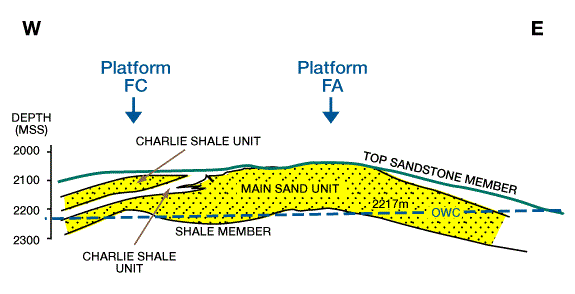Turbidite Models
Forereef sand bodies are important prospects in many provinces, such as the Permian, Anadarko, Gulf Coast, and North Sea basins. The richest potential prospects are situated seaward of abrupt ancient continental slopes.
Even after a reef has died, perhaps by influx of clastics from an uplifted hinterland, its form may still influence the depositional trends of subsequent prospective sands. In the Gulf Coast of the United States, the late Lower Cretaceous Edwards reef together with the continental shelf edge (which itself may have been caused by an earlier Lower Cretaceous Sligo reef) determine the positions, and indirectly, the thicknesses of deltaic and associated turbidite sequences of the Woodbine and Tuscaloosa Formations (Figure 1).

Where the Edwards reef front does not coincide with the shelf edge (Figure 2),a relatively thin and commercially second-rate sequence of Woodbine deltaic and strandline sands were deposited.

Where the Edwards reef front over-lies the shelf edge (Figure 3),a thick sequence of Tuscaloosa turbidite sands accumulated.

These contain several important fields rich in gas condensate. Evidently one would search for prospects preferentially in the thick turbidite facies, initially by analysis of seismic profiles, and later by analysis of well logs.
Detailed log analysis of turbidite sand reservoirs is particularly advanced in the North Sea, where Eocene and Paleocene turbidites are productive in major fields such as Frigg, Balder, and Forties. For example, the Forties field in the United Kingdom Sector contains four billion barrels of oil-in-place in sands of a middle to lower submarine fan (Figure 4).

One lobe of this fan (the Charlie sand unit) shales out up-slope on the Forties-Montrose ridge. From pressure decline data, this unit is shown to be a partly isolated reservoir (Figure 5).

One of the major problems in prospect delineation of deep-water turbidites is the lack of reservoir continuity. Interpreting reservoir continuities and discontinuities, which are due to the extremely rapid facies changes in the turbidite fan, is accomplished by sequential log pattern analysis. This involves correlating the depositional events as described by the log patterns (Figure 6).





This “may require dissimilar log picks to be correlated. The results are meaningful in terms of defining sand body geometries and likely reservoir drainage patterns” (Figure 11, The interpreted depositional history of the Charlie sand unit based on sequential log pattern analysis.

(1) Lower fan shales; (2) Middle fan channel sands; (3(a)) Prograding lobes on the suprafans; (3(b)) Lower fan/interchannel deposition; (4) Middle fan channel sands; and (5) Lower fan shales with rare lobe sands).
Conclusion
In the realm of petroleum geology, prospect modeling stands as a cornerstone for successful resource exploration. By integrating various data sets, employing advanced techniques, and leveraging technological advancements, geoscientists can construct robust prospect models that aid in decision-making processes. The comprehensive understanding of subsurface structures, reservoir characteristics, and migration pathways provided by prospect modeling helps minimize exploration risks and maximize the potential for discovering economically viable oil and gas reserves.
With our unwavering commitment to excellence in petroleum geology, we strive to provide you with the most insightful and comprehensive information to drive your exploration endeavors forward. Stay at the forefront of the industry by leveraging the power of prospect modeling and unlock the secrets of resource exploration.
 Petro Shine The Place for Oil and Gas Professionals.
Petro Shine The Place for Oil and Gas Professionals.



